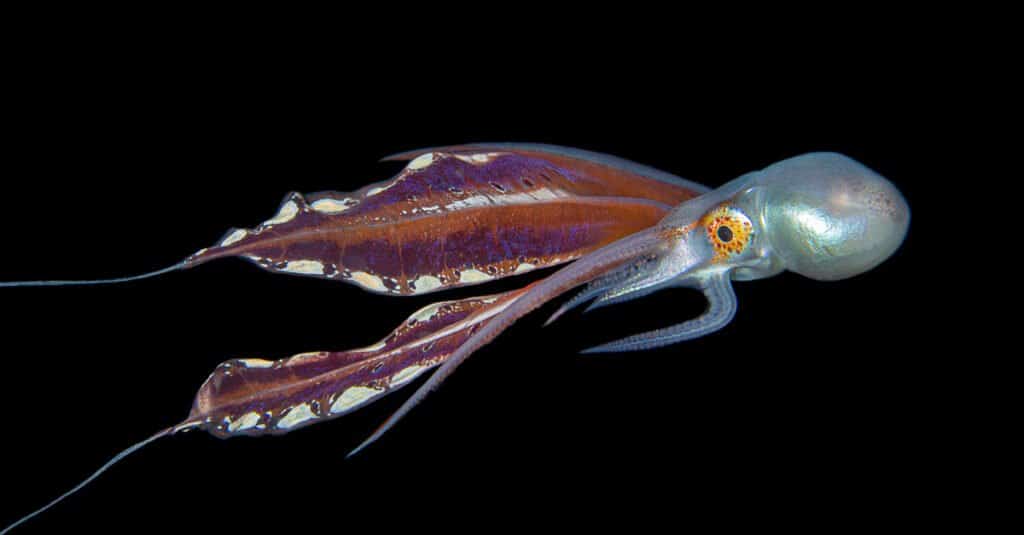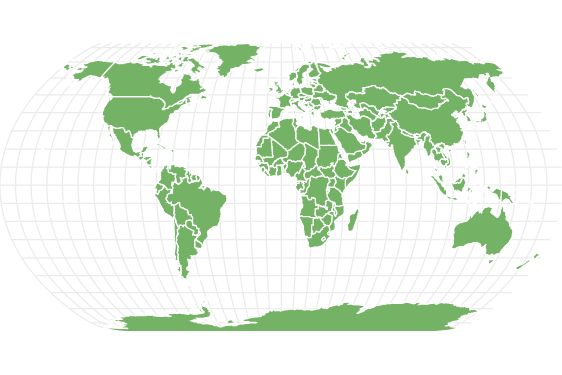Blanket Octopus
.jumbotron {
background-image: url(“https://a-z-animals.com/media/2022/02/Blanket-Octopus-header-400×300.jpg”);
}
}
@media only screen and (min-width: 641px) and (max-width: 920px) {
.jumbotron {
background-image: url(“https://a-z-animals.com/media/2022/02/Blanket-Octopus-header-470×370.jpg”);
}
}
@media only screen and (min-width: 921px) {
.jumbotron {
background-image: url(“https://a-z-animals.com/media/2022/02/Blanket-Octopus-header.jpg”);
}
}
Blanket Octopus
Females can weigh up to 40,000 times more than their partners.
Blanket Octopus Facts
- Prey
- Small fish
- Group Behavior
-
- Solitary
- Fun Fact
- Females can weigh up to 40,000 times more than their partners.
- Estimated Population Size
- Unknown, but status is Least Concern
- Biggest Threat
- Natural predators
- Most Distinctive Feature
- Billowing cape (F), tiny size (M)
- Habitat
- Surface to mid-water, Coral reef
- Predators
- Blue shark, billfish, tuna
- Diet
- Carnivore
- Type
- octopoda
- Common Name
- Blanket octopus
- Number Of Species
- 4
This post may contain affiliate links to our partners like Chewy, Amazon, and others. Purchasing through these helps us further the A-Z Animals mission to educate about the world’s species..

Spiders that fly! Fish that walk! And 1000+ more incredible animals. Discover them all for FREE
.photo-gallery {
–margin: 0px auto 0px;
–padding: 0px 0px 0px 0px;
}
.gallery-link {
background-image: url(“https://a-z-animals.com/media/2022/02/Blanket-Octopus-header-1024×535.jpg”);
background-repeat: no-repeat;
background-size: cover;
background-position: center;
height: 500px;
justify-content: center;
text-align: center;
align-items: center;
display: flex;
border: 2px solid #000;
}
.gallery-link img {
height: 50%;
}
@media only screen and (max-width: 768px) {
.gallery-link {
height: 300px !important;
}
}
View all of the Blanket Octopus images!
The blanket octopus gets its name from the unique skin webbing that connects together its legs in a manner that resembles a rainbow blanket.
However, the trait for which these octopi are named only manifests in females. Males are a fraction of the size of their feminine counterparts, with the latter weighing up to 40,000 times that of the former. That makes the blanket octopus the most dramatically sexually dimorphic animal on the planet, but it’s not this cephalopod’s only interesting quality. Though sightings of rainbow blanket octopi are often rare, the facts we do know about the four species known as the rainbow octopus reveal a versatile and highly intelligent sea creature capable of surviving in a range of different environments.
3 Incredible Blanket Octopus facts!
- Little Men: Males don’t possess the trademark rainbow blanket this octopus is known for, but they’re also barely the size of a walnut. In fact, they’re so difficult to sight that live masculine specimens weren’t even identified in the wild until the early 2000s.
- Endless Wanderlust: Blanket jellyfish are highly nomadic and highly solitary creatures that can adapt to both tropical and subtropical conditions. But they’re also known to demonstrate diel vertical migration — moving from the surface of the water at night to depths exceeding four miles
- Barbaric Tool Use: Their trademark blanket provides an effective method for scaring off predators, but they also demonstrate a more aggressive stance. They’re known to rip the arms off of the poisonous man o’ war jellyfish and wield them as defensive weapons.
Blanket Octopus Classification and Scientific name
The blanket octopus refers to four different species known for possessing a distinctive membrane that connects together their eight legs. These species are all identified under the genus Tremoctopus. While the exact etymology of this genus name is uncertain, it may be a reference to the trembling or quivering sensation of their blanket being unfurled. The four species are Tremoctopus gelatus, Tremoctopus gracilis, Tremoctopus robsoni, and Tremoctopus violaceus.
Blanket Octopus Species
While there are four identified blanket octopus species, these animals are still so rarely observed that there’s little information on what traits distinguish them from one another. Functionally, all members of the genus are known for sharing their dramatic sexual dimorphism as well as the characteristic blanketed webbing. The violent blanket octopus — Tremoctopous violaceus — is the most well-studied of the different species and is the source for most of our information on the genus as a whole.
- Common blanket octopus (Tremoctopus violaceus): The most common species, it’s found in most of the major saltwater bodies and has been spotted in waters ranging from Africa to Europe to North America.
- Gelatinous blanket octopus (Tremoctopus gelatus): This species can be found in Madagascar and off the United States‘ southeast coast in Florida’s waters.
- Tremoctopus gracilis: One of the rarer species, it’s endemic to the waters surrounding Taiwan.
- Tremoctopus robsoni: Native to the southwest Pacific, it’s most commonly spotted around New Zealand.
Blanket Octopus Appearance
Male and female members of the species are so dramatically different as to appear as if they belong to different species entirely. The latter can reach lengths of six feet and possess the beautiful but intimidating blanket that earns them their name, while males are the size of a small nut and have no cape at all. Apart from that sexual dimorphism and the dramatic membrane of flesh, they aren’t physiologically that different from other octopus species. They can appear in a wide range of different colors, and they can even change their patterning and coloration to better blend in with their environment like many other octopus species.

Sam Robertshaw/Shutterstock.com
Blanket Octopus Distribution, Population, and Habitat
The blanket octopus is rarely seen in the wild, but its distribution seems to be prolific. These cephalopods have been found in the Australian Great Barrier Reef, in the Gulf of Mexico, and in both the Mediterranean Sea and the Indian Ocean. Part of this has to do with their nomadic and solitary behavior, but their ability to adapt to both tropical and subtropical water conditions also helps with that. These octopi exhibit a behavior known as diel vertical migration. They’ll spend their evenings at or near the surface of the water, but they can descend as deep as four miles deeper as it grows lighter above.
Blanket Octopus Predators and Prey
Since they’re found across such a geographically dramatic range, the exact species of animals that serve as prey are hard to pin down. They primarily feed on small fish, though the dramatic size discrepancy means that the species of fish they actively seek out can vary between the two genders. They employ both their beaks and their tentacles to hunt in the way that most octopi species do, but they also use a more morbid and ingenious tool: the tentacles of the man o’ war. This jellyfish’s stinger-tipped tentacles are naturally paralytic, and blanket octopi have developed an immunity to the jellyfish’s toxin. They’ll tear free these tentacles to swing at their prey. Baby blanket octopi have been rarely seen in the wild, but they likely feed off of plankton as they grow into adults.
While the blanket octopus may be cunning, it’s small enough to be obvious prey for a number of different ocean predators and doesn’t possess any natural toxins of its own. Larger fish like billfish and tuna are often predators of the blanket octopus, as are blue sharks. Whales have been known to feed on blanket octopi as well. But the blanket octopus also has a unique defensive mechanism. When faced with a threat, the first reaction of this octopus is to inflate its blanket to make it appear larger and more intimidating. And if this doesn’t work, it can detach its blanket entirely to tangle up its pursuer and get a head start in its escape.
Blanket Octopus Reproduction and Lifespan
Since they mostly occupy open waters, the life cycle of the blanket octopus hasn’t been observed as much as many other species. Like all cephalopods, the blanket octopus is semelparous. That means that they die shortly after mating. Males typically live for a year or two, while females will live to the age of two or three. Dwarf males use all of their energy trying to find a mate.
The third right arm of the male serves as a sexual organ, and they actually detach it from their body and leave it inside the female during mating. They’ll die shortly thereafter. The process is at least as exhausting for female blanket octopi. They can carry up to 100,000 eggs until the point that they’re ready to hatch. After laying her eggs, a mother octopus will simply stop feeding and quickly die.
Blanket Octopus in fishing and cooking
The blanket octopus isn’t used in any known cuisine, and it’s only caught unintentionally by fishing nets. The corpses of masculine octopuses are sometimes caught in plankton nets, but an instance of catching their larger counterparts is far rarer.
Blanket Octopus Population
The IUCN Red List has all four species of the blanket octopus listed as species of least concern, and they were last assessed in 2014. Despite that, these are elusive and solitary creatures that can be hard to find because they occupy deeper waters during the day and emerge to the surface only in the evening. That makes it difficult to estimate the population size for any of the four species. Wherever they’re found, these species thrive on coral reef habitats. And while the blanket octopus may not be under direct threat from fishers or poachers, their habitats are. Destructive practices in mining, drilling, fishing, and coastal development can ravage coral structures and have a dramatic rippling effect throughout the entire ecosystem. This is an existential challenge for the future of coral reefs, and one that challenges these octopi as well as countless other species.
View all 192 animals that start with B
Blanket Octopus FAQs (Frequently Asked Questions)
Where are blanket octopuses found?
While rarely seen, these octopi seem to have a wide distribution throughout the world. They can shift between tropical and subtropical environments. Though they’re most commonly seen in the Atlantic Ocean off the west coast of the Americas, they’ve also been found in the Mediterranean Sea and the Indian Ocean.
What is the difference between a blanket octopus and a man o war?
One is a variety of octopus species known for possessing a billowing cape of flesh that they can use to intimidate and confuse predators. The other is a jellyfish known for its toxic sting. But the blanket octopus is also immune to that poison and has been observed ripping free man o’ war arms and using them as weapons.
What is the difference between a male and female blanket octopus?
The biggest difference is one of size. With a maximum length of six feet, blanket octopus females are typically tens of thousands of times heavier than their masculine counterparts.
Sources
- ITIS, Available here: https://www.itis.gov/servlet/SingleRpt/SingleRpt?search_topic=TSN&search_value=82667#null
- Scientific American, Available here: https://blogs.scientificamerican.com/octopus-chronicles/unusual-offshore-octopods-the-weapon-wielding-blanket-octopus-video/
- Science Daily, Available here: https://www.sciencedaily.com/releases/2015/03/150310205703.htm
- Leisure Pro, Available here: https://www.leisurepro.com/blog/explore-the-blue/5-blanket-octopus-facts/
- Great Barrier Reef Foundation, Available here: https://www.barrierreef.org/the-reef/animals/blanket-octopus
















